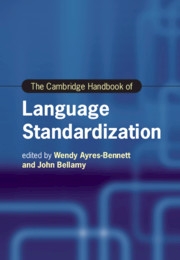Book contents
- The Cambridge Handbook of Language Standardization
- cambridge handbooks in language and linguistics
- The Cambridge Handbook of Language Standardization
- Copyright page
- Contents
- Figures
- Tables
- Contributors
- Introduction
- Part I Revisiting Models and Theories of Language Standardization
- Part II Legitimacy, Authority and the Written Form
- Part III Norms, Literacy and Education
- Part IV Beyond the National
- 19 Transnational Standards of Languages
- 20 Standardization across State Boundaries
- 21 Language Modernization in the Chinese Character Cultural Sphere
- 22 Linguistic Norms, Centre–Periphery Dynamics and the Tension between Uniformity and Diversity in Processes of Standardization
- 23 When Ethnic Boundaries and Language Boundaries Mismatch
- 24 The Standardization of a Stateless Language
- Part V Standardization in Late Modernity
- Name Index
- Subject Index
- References
24 - The Standardization of a Stateless Language
from Part IV - Beyond the National
Published online by Cambridge University Press: 01 July 2021
- The Cambridge Handbook of Language Standardization
- cambridge handbooks in language and linguistics
- The Cambridge Handbook of Language Standardization
- Copyright page
- Contents
- Figures
- Tables
- Contributors
- Introduction
- Part I Revisiting Models and Theories of Language Standardization
- Part II Legitimacy, Authority and the Written Form
- Part III Norms, Literacy and Education
- Part IV Beyond the National
- 19 Transnational Standards of Languages
- 20 Standardization across State Boundaries
- 21 Language Modernization in the Chinese Character Cultural Sphere
- 22 Linguistic Norms, Centre–Periphery Dynamics and the Tension between Uniformity and Diversity in Processes of Standardization
- 23 When Ethnic Boundaries and Language Boundaries Mismatch
- 24 The Standardization of a Stateless Language
- Part V Standardization in Late Modernity
- Name Index
- Subject Index
- References
Summary
The chapter outlines standardization efforts in Romani, where geographical dispersion and the absence of strong community institutions pose challenges to efforts towards unification, status regulation and domain expansion. Initial standardization efforts were localized and partly state sponsored, while others were promoted by networks of activists and supported by civil society initiatives as well as by European governance institutions. Transnational mobility since the mid-1990s, the expansion of electronic communication and the proliferation of both political networking and religious missionary activities among Romani communities have provided incentives and means for domain expansion. Romani literacy is characterized by the use of multiple variants in the choice of dialect and orthography. I show how the key features of ‘standardization beyond the state’, such as the role of networking among multiple actors and pluralism of form, are reinforced through the growing role of multinational institutions, increased mobility and the rise of electronic communication.
Keywords
- Type
- Chapter
- Information
- The Cambridge Handbook of Language Standardization , pp. 645 - 664Publisher: Cambridge University PressPrint publication year: 2021



